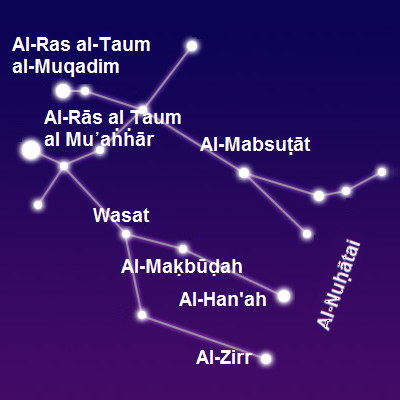


|
|
Middle EastMiddle Eastern Star LoreE - N |
|


|
|
Gemini
R.H. Allen gives two Arabic names for the
constellation, both meaning "Twins." The older one was برج الجوزاء - Al Burj al Jauzā, the other one, used by Arab astronomers was
التوأمان - Al Tau᾽amān.
The stars of Gemini are also part of the ancient Arabic mega-constellation |

|

In the Al-Asad constellation, Gemini's brightest stars, now known as
Castor (α Gem) and Pollux (β Gem), formed
the paw of Adh-dhira’a al-Mabsuta, The Extended Forearm. In that constellation,
they were called Al Awwal al Dhirāʽ (α Gem) and Al Thānī al Dhirāʽ (β Gem), the First and the Second in the Forearm.
 Al-Azfar, The Claws were formed by ρ, τ, ι, υ, κ, δ, λ, ζ and ε Geminorum.  Sources: R.H. Allen, Arab Star Calendars. Many of today's common names of Gemini's main stars are of Arabic origin: |
 Extended Forearm and Claws
Extended Forearm and ClawsSource: Arab Star Calendars |

|

|
Official names derived from Arabic origins are shown in bold.
|

|
Around 964 AD, Persian astronomer Abd al-Rahman al-Sufi published his
Book of Fixed Stars, in which he assigned Arabic names to the stars and constellations identified
800 years earlier in Ptolemy's Almagest.
Al-Ras al-Taum al-Muqadim (α Gem) - The Head of the foremost Twin - was the name given
by Arabic astronomers to the star known as Castor in Greek astronomy.
|
 Colored Egyptian copy of
Colored Egyptian copy ofal-Sufi's illustration Source: diomedia.com
|

Al-Rās al Taum al Mu᾽aḣḣār (β Gem) - The Head of the hindmost Twin - was the name given
by Arabic astronomers to the star known as Pollux in Greek astronomy.
 In the ancient Arabic mega-constellation Al-Asad, the star was named Al Thānī al Dhirāʽ - the Second in the Forearm. al-Muwaqqit used the name Muekher al Dzira, the End of the Paw.  Sources: R.H. Allen, Wikipedia.
α and β Geminorum formed the Seventh
Arabic Lunar Mansion, named adh-dhira’ after the "Extended Forearm" in the
Al-Asad constellation.
Alhena (γ Gem) comes from the Arabic Al Hanʽah, meaning "the Brand" (on the neck of the camel).
|

Wasat (δ Gem) is the Arabic word for "Middle" which can be seen as the middle of the constellation but
according to R.H. Allen can also relate to to
the position of the star very near to the ecliptic, the central circle.
 Source: R.H. Allen
The names of Mebsuta (ε Gem) and
Mekbuda (ζ Gem) date back to the ancient Lion constellation
Al-Asad. Together with
ρ,
τ,
ι,
υ,
κ,
δ and
λ Geminorum, they formed the Claws
of the lion.
Alzirr (ξ Gem) comes from the Arabic al-zirr, meaning "Button. No explanation
for the origin of the name is given.
|
 Arabic Names of the stars of Gemini
Arabic Names of the stars of GeminiChart done by the author based on a map by seasky.org |



|
|
Leo
Before abd al-rahman al-sufi and other Arabic astronomers adopted
Ptolemy's constellations, people on the
Arabian Peninsula had their own way to navigate the sky, creating constellations like Lam, Ostriches and
Vulture.
|
 Author's sketch of al-asad, based on a presentation by Danielle Adams
Author's sketch of al-asad, based on a presentation by Danielle AdamsClick the image to see the original in the Arab Star Calendars |

Danielle Adams at the University of Arizona in Tucson has developed an excellent project called Arab Star Calendars to preserve
the astronomical knowledge of the people of the Arabian Desert.
 The largest of these Arabian constellations is al-asad, the Lion. Covering 135 angular degrees of the northern sky, it is perhaps the largest constellation ever conceived by stargazers. R.H. Allen (in Star Names: Their Lore and Meaning) called is a "monstrosity", Danielle Adams, (in the Arab Star Calendars) much more appropriately calls it a "Celestial Complex".  Danielle Adams provides an extensive description of all sections of this celestial complex.  She writes: |

"The Lion of ancient Arabia was so massive that it roared from January to May, stretching across three seasons in its pre-dawn stellar settings, according to
the rain star calendar of Qushayr. The cold season of winter continues with the setting of the Two Forearms and then the Nose of the Lion. The setting of the
Forehead of the Lion marks the end of winter and the onset of the warm spring rains. Some weeks later, the Two Shanks of the Lion set about 40 days apart,
defining between them the rainy portion of the summer.
 All of this seasonal rain activity unfolds over the course of about four months, between the morning settings of the two brilliant pairs of stars (its Two Forearms and its Two Shanks) that roughly define the boundaries of the Lion." |
  Colored reproduction of al-sufi's illustration
Colored reproduction of al-sufi's illustrationSource: Stuart Rankin; taken at the Library of Congress |

Here is a listing of all stars of the different segments of the al-asad celestial complex.
 Clicking on the headline name of a segment takes you to an extensive description of that segment in the Arab Star Calendars, which provides a lot more valuable information. |

|
The Clenched Forearm adh-dhira’ al-maqbuda الذراعة المقبوضة Procyon (α Cmi) Gomeisa (β Cmi)
The Extended Forearm
Collectively, The Clenched Forearm
The Claws
The Two Nostrils
The Sneeze |
Collectively, The Two Nostrils and The Sneeze are The Nose of the Lion anf al-asad - أنف الأسد
The Eyes
The Eyelashes
The Forehead
The Mane
The Sheath of the Penis |
The Two Haunches al-warikan - الوركان Zavijava (β Vir) Porrima (γ Vir) Minelauva (δ Vir) Vindemiatrix (ε Vir) Zaniah (η Vir)
The Two Shanks
The Rump
The Tail Hair
The Tail Hair Strikes |

|
In her Star Calendar Blog, Danielle Adams kept the memories of this magnificent
constellation alive. Check out her essays on the Roaring of the Lion, the Dog Tooth of Time and the Sky-Raisers. |

 The Protracted Roaring of the Lion
The Protracted Roaring of the LionAbundant rains from an ancient beast |
 The Smiling Dog Tooth of Time
The Smiling Dog Tooth of TimeThe Lion brings warmer weather |
 The Setting of the Sky-Raisers
The Setting of the Sky-RaisersWidespread rains of summer |



|
|
Medieval Islamic Astronomy
Throughout the Middle East, the constellation is called Lion in many languages. The Persians called it Ser or Shir;
the Turks Artan; the Syrians Aryo; the Jews Arye; all meaning "lion."
in the Book of Fixed Stars, Persian astronomer
Abd al-Rahman al-Sufi adopted
Ptolemy's constellations, but there was an original Arabic Lion
constellation long before that (see below).
|

|

|

|
Official names derived from Arabic origins are shown in bold.
|

Regulus (α Leo) is Latin for "prince" or "little king."
In Arabic, the star was called qalb al-asad, meaning "Heart of the Lion." While in this case the Latin name prevailed, many of the other stars in Leo
kept their Arabic names.
 Source:Wikipedia
Denebola (β Leo) is shortened from Deneb Alased, from the Arabic phrase ðanab al-asad
"tail of the lion."
Algieba (γ Leo) originated from the Arabic al-jabhah, meaning "the forehead."
Zosma (δ Leo) is derived from the Arabic al-zubra, which can mean both "Shoulder" and
"Lion's Mane."
Ras Elased Australis (ε Leo) and
Ras Elased Borealis (μ Leo) are combinations of Arabic and Latin. The original names were
al rās al asad al janūbiyyah and al rās al asad al shamaliyy, meaning "The Southern Star in the Lion's Head" and "The Northern Star in the Lion's Head",
respectively. "Southern" and "Northern" were later replaced with the Latin expressions Australis and Borealis.
|
  15th century copy copy of
15th century copy copy ofal-Sufi's illustration Pergamenthandschrift M II 141, Source:atlascoelestis.com
|

Chertan (θ Leo) is derived from the Arabic al-kharātān "two small ribs", originally
referring to δ and θ Leonis.
 Source:Wikipedia
Adhafera (ζ Leo) comes from the Arabic aḍ-ḍafīrah "the braid/curl", a reference to the lion's mane.
Al Jabhah (η Leo) means "the Front" or "the Forehead" (of the lion).
|

Al Minliar al Asad (κ Leo) means the "Muzzle of the Lion."
 Source:Wikipedia
Alterf (λ Leo) comes from the Arabic aṭ-ṭarf, meaning "the view" or "the Eyes"
(of the lion). .
Subra (ο Leo) is derived from the Arabic Arabic al-zubra, which can mean, "Shoulder",
"Lion's Mane" or "upper part of the back."
|
  Leo in The Book of the Birth of Iskandar
Leo in The Book of the Birth of IskandarSource: wellcomecollection.org |



|
|
Leo Minor
The Borgian Globe
|
 al thibā᾽ wa‑aulāduhā on the Borgian Globe
al thibā᾽ wa‑aulāduhā on the Borgian GlobeSource: atlascoelestis.com |
 R.H. Allen cites two different interpretations. German astronomer C.L. Ideler described the formation as al thibā᾽ wa‑aulāduhā, a Gazelle with her Young. Arabist Friedrich Wilhelm Lach, on the other hand, called it al haud, the Pond (into which the Gazelle jumps).  Sources: R.H. Allen, atlascoelestis.com |



|
|
Lyra
The brightest star in the constellation Lyra is Vega. According to
Ian Ridpath, the name "... comes from the Arabic words al-nasr al-waqi’ that can mean
either ‘the swooping eagle’ or ‘vulture’, for the Arabs saw both an eagle and a vulture here. The constellation was often depicted on star maps as a
bird positioned behind a lyre ... It seems that the Arabs visualized Vega and its two nearby stars Epsilon and Zeta Lyrae as an eagle with folded
wings, swooping down in its prey, whereas in the nearby constellation Aquila,
the star Altair and its two attendant stars gave the impression of a flying eagle with wings
outstretched."
|

|



 
 
|